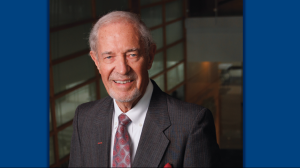John Karickhoff: Bringing the Light of Innovation to Duke Eye Center
In addition to being a talented teacher, surgeon, and humanitarian, John Karickhoff, MD'64, HS‘64-'68, is a visionary. He recently gave $1 million to launch the Duke Ocular Innovation Hub. The hub will serve both as an engine to drive innovation and a repository for innovations developed at Duke Eye Center.
Karickhoff wants every trainee at Duke to think about how they can advance ophthalmology and to consider making innovation their career focus. To him, innovation is at the heart of every advance in medicine.
“I realized that receiving my AB and MD degrees, teaching for 30 years at Georgetown University Medical School, and performing surgery on thousands of people is a worthy career, but none of those activities advanced my profession or will be part of the history of medicine,” Karickhoff said. “It is only innovation, by definition, that advances the art and science of medicine and gives something new to humanity.”
A West Virginia native, Karickhoff graduated magna cum laude from Marshall University while serving as class president his freshmen through junior years and as president of the student body his senior year. After completing eight years of medical training at Duke, he served in Vietnam in the United States Army Medical Corps. In addition to his army responsibilities, he set up a clinic that provided free cataract surgery for Vietnamese civilians. He performed over 500 surgeries, secured donated glasses for his patients, and organized medical teams to provide care in nearby villages. For this work, the Army awarded him the Bronze Star.
Karickhoff became the world authority on laser treatment of eye floaters and has invented or designed more than 20 innovations, including devices, like the Karickhoff laser lens, that are used worldwide. His introduction to innovation came in 1979 when he read an article that suggested that people who had good ideas should give them to companies to develop.
“I had an idea and shared it with a company that developed ocular equipment,” said Karickhoff. “They developed a prototype, and we sent it back and forth, improving it with each iteration. I even wrote the advertisement for the device because they didn’t fully understand the device’s importance. And that was the end of it. Then several months later, while attending a national meeting, I stopped by their booth to ask if they had ever sold any. They said, ‘Did we ever. We sold almost $600,000 worth of your device at $475 apiece!’ In the end, they made a lot of money, and I got a framed copy of my advertisement and the knowledge that if I had an idea and worked long enough on it, I could make something good. That was all the reward I needed.”
That device, the Karickhoff laser lens, is still used today. Karickhoff intentionally donates almost all of his innovations and inventions to benefit ophthalmology. One invention he trademarked, the Karickhoff Mosaic MatcherTM, allows surgeons to quickly and easily estimate the number of corneal endothelial cells prior to surgery — an important factor in determining whether the cornea will remain clear after surgery. The device was freely distributed and is the most widely used device of its kind in the world.
Karickhoff’s unique 40-year research achievement is that he developed an innovation or significant advance for each of the 14 anatomic parts of the human eye, as documented in his book “Laser Treatment of Eye Floaters.”
Karickhoff’s eyes light up when he talks about innovation. He wants to spark that same enthusiasm among trainees at Duke.
“Developing something new that no one has ever done before has given me the greatest satisfaction and happiness in my career,” said Karickhoff. “My main hope is that these extremely talented trainees will stop for a second before they embark on their careers and consider creating something new that will change the course of ophthalmology. To me, innovation is the most important word in medical education.”
The Ocular Innovation Hub will drive innovation through six activities: teaching trainees and faculty how to move an idea to market, recognizing top innovations with annual awards, highlighting exciting innovations from across the field of ophthalmology through a guest lecture series, funding faculty research, funding trainee research (including paying research article publishing fees), and creating a robust repository of Duke ocular innovations.
“I have a keen interest in innovation, given part of my work is exploring new ways to use ocular imaging to improve eye exams and surgery,” said Anthony Kuo, MD, vice chair of technology in the Department of Ophthalmology. “As such, the department and I share Dr. Karickhoff’s vision. The hub and seed funding will provide our faculty and trainees with the resources and access they need to bring their ideas to fruition, adding to the rich legacy of innovation in our specialty.”
Karickhoff, a longtime supporter, chose Duke for the innovation hub because of the excellence of the trainees and his high regard for Duke itself.
“Duke is where I got my professional start in life,” said Karickhoff. “And I knew that much of my education had been paid for by the gifts of previous graduates.”
Duke Eye Center, opened in 1973, has grown considerably to become an internationally-renowned academic medical institution. With a long track record of developing innovative treatments, providing excellence in care, and training leaders in the field, it has been consistently ranked as a top ten center for over 30 years.
“Dr. Karickhoff’s generous gift is a vital investment in the future of ophthalmology, empowering our faculty and trainees to make lasting impacts in the field through innovation,” said Edward Buckley, MD, chair of the Department of Ophthalmology. “We are immensely grateful for his support, and we hope that others will be inspired to follow in his footsteps, helping to ensure the continued excellence of Duke Eye Center.”



